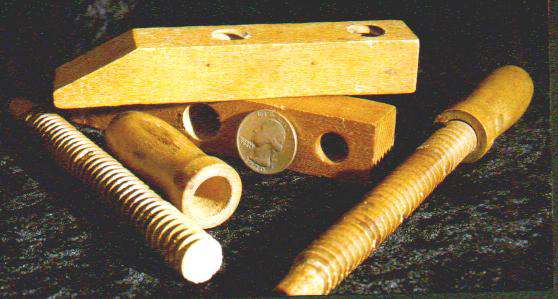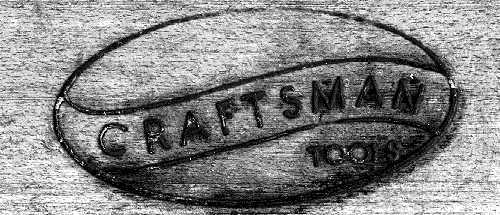
Top of Site > Clamps as Products > Brands of Clamps (CC) > Craftsman
Table of Contents
These were made for Sears, by Hempe Mfg Co of New
Berlin,Wisconsin. There are apparently several variations.
(A) They may be solid wood, or laminated of contrasting light and
dark woods.
(B)The holes in the stopped jaw may have different, or the same,
diameter. This corresponds to differences in the two spindles, or
identity of spindles.
There is only one Craftsman clamp in the editor's collection. John Adams has provided a picture of the one he has. See one in an original box .
This is classic tool number 2 in a 4 tool series. It is "Branded" American Home Workshop Classic Tool.
The production limit on these tools was 25,000 pieces and each tool has its own serial number and certificate of authenticity. The serial number is embossed on the commemorative Craftsman logo medallion. With the enclosed certificate of registration the date the tool was made may be obtained.
Each clamp is different with distinct wood patterns. The striking contrast of beautiful maple and walnut hardwoods highlights the all wood construction of the classic Craftsman wood clamp.
This hand screw clamp is made of Maple with Walnut inlay and handles. Each jaw is approximately 9 3/4" long by 1 3/4" wide by 1 3/4 deep. The box that it comes in is approximately 17 1/2" by 12 1/2".
Readers are invited to make known any other examples that exist.
This page contains pictures and descriptions of
These will show the several ways that the clamp was designed for ease of production.

The two spindles can be identical. The shaft has a continuous thread, without a special tip or clear section. The shaft is cut to length, and glued into the handle. The handles are made as separate items, with a hole bored to receive the threaded shaft.
The result is that spindles can be made, mostly by machines, with a minimum of labor, and that labor mostly unskilled.
An apparently earlier version has distinct spindles. The
stopped spindle lacks its thread at the tip or end, and therefore
fits into a smaller diameter pit or hole.

This example, from John Adam's collection, differs in some
particulars from the one in my collection. The stopped spindle is
not threaded to the end, and the holes in the stopped jaw are not
the same diameter. I suspect this is an earlier version, before
the design was simplified.

The large mark is prominent on the top side of the clamp, rather than on the back, or the outside. It appears to be burned in, but I am not certain. The color could be the result of the stain. The depth and width of the "cut" are very even, and the sides are nearly vertical, so that it does not look like a stamping, more like a routing. However, routing would seem to be too expensive.
The stopped jaw in this sample has two holes of the same diameter. This simplifies the manufacture, avoiding the use of different machines.
The specimen I have was stained on the surface, and some stain
dribbled into the borings of the stopped jaw.
TBD
last revised and validated
Copyright © 1996- Wooden Clamp Journal